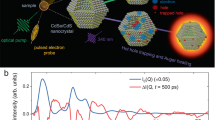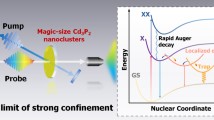Abstract
In CdS nanocrystals, photoexcited holes rapidly become trapped at the particle surface. The dynamics of these trapped holes have profound consequences for the photophysics and photochemistry of these materials. Using a combination of transient absorption spectroscopy and theoretical modelling, we demonstrate that trapped holes in CdS nanorods are mobile and execute a random walk at room temperature. In CdS nanorods of non-uniform width, we observe the recombination of spatially separated electrons and trapped holes, which exhibits a t−1/2 power-law decay at long times. A one-dimensional diffusion–annihilation model describes the time-dependence of the recombination over four orders of magnitude in time, from one nanosecond to ten microseconds, with a single adjustable parameter. We propose that diffusive trapped-hole motion is a general phenomenon in CdS nanocrystals, but one that is normally obscured in structures in which the wavefunctions of the electron and trapped hole spatially overlap. This phenomenon has important implications for the oxidation photochemistry of CdS nanocrystals.



Similar content being viewed by others
References
Bawendi, M. G., Steigerwald, M. L. & Brus, L. E. The quantum mechanics of larger semiconductor clusters (‘quantum dots’). Annu. Rev. Phys. Chem. 41, 477–496 (1990).
Peng, X. G. et al. Shape control of CdSe nanocrystals. Nature 404, 59–61 (2000).
Burda, C., Chen, X. B., Narayanan, R. & El-Sayed, M. A. Chemistry and properties of nanocrystals of different shapes. Chem. Rev. 105, 1025–1102 (2005).
Kamat, P. V. Quantum dot solar cells. Semiconductor nanocrystals as light harvesters. J. Phys. Chem. C 112, 18737–18753 (2008).
Talapin, D. V., Lee, J. S., Kovalenko, M. V. & Shevchenko, E. V. Prospects of colloidal nanocrystals for electronic and optoelectronic applications. Chem. Rev. 110, 389–458 (2010).
Nozik, A. J. et al. Semiconductor quantum dots and quantum dot arrays and applications of multiple exciton generation to third-generation photovoltaic solar cells. Chem. Rev. 110, 6873–6890 (2010).
Han, Z. J., Qiu, F., Eisenberg, R., Holland, P. L. & Krauss, T. D. Robust photogeneration of H2 in water using semiconductor nanocrystals and a nickel catalyst. Science 338, 1321–1324 (2012).
Wilker, M. B., Schnitzenbaumer, K. J. & Dukovic, G. Recent progress in photocatalysis mediated by colloidal II–VI nanocrystals. Isr. J. Chem. 52, 1002–1015 (2012).
Semonin, O. E. et al. Peak external photocurrent quantum efficiency exceeding 100% via MEG in a quantum dot solar cell. Science 334, 1530–1533 (2011).
Wu, K. F., Zhu, H. M., Liu, Z., Rodriguez-Cordoba, W. & Lian, T. Q. Ultrafast charge separation and long-lived charge separated state in photocatalytic CdS–Pt nanorod heterostructures. J. Am. Chem. Soc. 134, 10337–10340 (2012).
Wilker, M. B. et al. Electron transfer kinetics in CdS nanorod–[FeFe]-hydrogenase complexes and implications for photochemical H2 generation. J. Am. Chem. Soc. 136, 4316–4324 (2014).
Klimov, V., Bolivar, P. H. & Kurz, H. Ultrafast carrier dynamics in semiconductor quantum dots. Phys. Rev. B 53, 1463–1467 (1996).
Klimov, V. I., Schwarz, C. J., McBranch, D. W., Leatherdale, C. A. & Bawendi, M. G. Ultrafast dynamics of inter- and intraband transitions in semiconductor nanocrystals: implications for quantum-dot lasers. Phys. Rev. B 60, R2177–R2180 (1999).
Jones, M. & Scholes, G. D. On the use of time-resolved photoluminescence as a probe of nanocrystal photoexcitation dynamics. J. Mater. Chem. 20, 3533–3538 (2010).
Knowles, K. E., McArthur, E. A. & Weiss, E. A. A multi-timescale map of radiative and nonradiative decay pathways for excitons in CdSe quantum dots. ACS Nano 5, 2026–2035 (2011).
Peterson, M. D. et al. The role of ligands in determining the exciton relaxation dynamics in semiconductor quantum dots. Annu. Rev. Phys. Chem. 65, 317–339 (2014).
Wu, K., Du, Y., Tang, H., Chen, Z. & Lian, T. Efficient extraction of trapped holes from colloidal CdS nanorods. J. Am. Chem. Soc. 137, 10224–10230 (2015).
Jones, M., Lo, S. S. & Scholes, G. D. Quantitative modeling of the role of surface traps in CdSe/CdS/ZnS nanocrystal photoluminescence decay dynamics. Proc. Natl Acad. Sci. USA 106, 3011–3016 (2009).
Wu, K., Rodriguez-Cordoba, W. & Lian, T. Exciton localization and dissociation dynamics in CdS and CdS–Pt quantum confined nanorods: effect of nonuniform rod diameters. J. Phys. Chem. B 118, 14062–14069 (2014).
Klimov, V. I. Spectral and dynamical properties of multiexcitons in semiconductor nanocrystals. Annu. Rev. Phys. Chem. 58, 635–673 (2007).
Yu, W. W., Qu, L., Guo, W. & Peng, X. Experimental determination of the extinction coefficient of CdTe, CdSe, and CdS nanocrystals. Chem. Mater. 15, 2854–2860 (2003).
Wu, K. F., Rodriguez-Cordoba, W. E., Liu, Z., Zhu, H. M. & Lian, T. Q. Beyond band alignment: hole localization driven formation of three spatially separated long-lived exciton states in CdSe/CdS nanorods. ACS Nano 7, 7173–7185 (2013).
Infelta, P. P., Gratzel, M. & Thomas, J. K. Luminescence decay of hydrophobic molecules solubilized in aqueous micellar systems. A kinetic model. J. Phys. Chem. 78, 190–195 (1974).
Tachiya, M. Application of a generating function to reaction kinetics in micelles. Kinetics of quenching of luminescent probes in micelles. Chem. Phys. Lett. 33, 289–292 (1975).
Sadhu, S., Tachiya, M. & Patra, A. A stochastic model for energy transfer from CdS quantum dots/rods (donors) to Nile Red dye (acceptors). J. Phys. Chem. C 113, 19488–19492 (2009).
Utterback, J. K. et al. Competition between electron transfer, trapping, and recombination in CdS nanorod–hydrogenase complexes. Phys. Chem. Chem. Phys. 17, 5538–5542 (2015).
Redner, S. A Guide to First-Passage Processes (Cambridge Univ. Press, 2001).
Kuno, M., Fromm, D. P., Hamann, H. F., Gallagher, A. & Nesbitt, D. J. Nonexponential ‘blinking’ kinetics of single CdSe quantum dots: a universal power law behavior. J. Chem. Phys. 112, 3117–3120 (2000).
Tang, J. & Marcus, R. A. Mechanisms of fluorescence blinking in semiconductor nanocrystal quantum dots. J. Chem. Phys. 123, 054704 (2005).
Frantsuzov, P., Kuno, M., Janko, B. & Marcus, R. A. Universal emission intermittency in quantum dots, nanorods and nanowires. Nature Phys. 4, 519–522 (2008).
Madelung, O. Semiconductors – Basic Data 2nd edn (Springer, 1996).
Nakade, S., Kambe, S., Kitamura, T., Wada, Y. & Yanagida, S. Effects of lithium ion density on electron transport in nanoporous TiO2 electrodes. J. Phys. Chem. B 105, 9150–9152 (2001).
Nelson, J. & Chandler, R. E. Random walk models of charge transfer and transport in dye sensitized systems. Coordin. Chem. Rev. 248, 1181–1194 (2004).
Wei, H. H. Y. et al. Colloidal semiconductor quantum dots with tunable surface composition. Nano Lett. 12, 4465–4471 (2012).
Sadhu, S. & Patra, A. Relaxation dynamics of anisotropic shaped CdS nanoparticles. J. Phys. Chem. C 115, 16867–16872 (2011).
Jasieniak, J. & Mulvaney, P. From Cd-rich to Se-rich—the manipulation of CdSe nanocrystal surface stoichiometry. J. Am. Chem. Soc. 129, 2841–2848 (2007).
Amirav, L. & Alivisatos, A. P. Photocatalytic hydrogen production with tunable nanorod heterostructures. J. Phys. Chem. Lett. 1, 1051–1054 (2010).
Acharya, K. P. et al. The role of hole localization in sacrificial hydrogen production by semiconductor-metal heterostructured nanocrystals. Nano Lett. 11, 2919–2926 (2011).
Brown, K. A., Wilker, M. B., Boehm, M., Dukovic, G. & King, P. W. Characterization of photochemical processes for H2 production by CdS nanorod–[FeFe] hydrogenase complexes. J. Am. Chem. Soc. 134, 5627–5636 (2012).
Berr, M. J. et al. Hole scavenger redox potentials determine quantum efficiency and stability of Pt-decorated CdS nanorods for photocatalytic hydrogen generation. Appl. Phys. Lett. 100, 223903 (2012).
Simon, T. et al. Redox shuttle mechanism enhances photocatalytic H2 generation on Ni-decorated CdS nanorods. Nature Mater. 13, 1013–1018 (2014).
Wu, K. F. et al. Hole removal rate limits photodriven H2 generation efficiency in CdS–Pt and CdSe/CdS–Pt semiconductor nanorod–metal tip heterostructures. J. Am. Chem. Soc. 136, 7708–7716 (2014).
Berr, M. J. et al. Delayed photoelectron transfer in Pt-decorated CdS nanorods under hydrogen generation conditions. Small 8, 291–297 (2012).
Yehezkeli, O., de Oliveira, D. R. B. & Cha, J. N. Electrostatically assembled CdS–Co3O4 nanostructures for photo-assisted water oxidation and photocatalytic reduction of dye molecules. Small 11, 668–674 (2015).
Duan, L. L. et al. A molecular ruthenium catalyst with water-oxidation activity comparable to that of photosystem II. Nature Chem. 4, 418–423 (2012).
Tseng, H. W., Wilker, M. B., Damrauer, N. H. & Dukovic, G. Charge transfer dynamics between photoexcited CdS nanorods and mononuclear Ru water-oxidation catalysts. J. Am. Chem. Soc. 135, 3383–3386 (2013).
Robinson, R. D. et al. Spontaneous superlattice formation in nanorods through partial cation exchange. Science 317, 355–358 (2007).
Peng, P., Sadtler, B., Alivisatos, A. P. & Saykally, R. J. Exciton dynamics in CdS–Ag2S nanorods with tunable composition probed by ultrafast transient absorption spectroscopy. J. Phys. Chem. C 114, 5879–5885 (2010).
Peterson, M. D., Jensen, S. C., Weinberg, D. J. & Weiss, E. A. Mechanisms for adsorption of methyl viologen on CdS quantum dots. ACS Nano 8, 2826–2837 (2014).
Press, W. H., Teukolsky, S. A., Vetterling, W. T. & Flannery, B. P. Numerical Recipes: The Art of Scientific Computing 3rd edn (Cambridge Univ. Press, 2007).
Acknowledgements
This work was supported by the Air Force Office of Scientific Research under AFOSR award No. FA9550-12-1-0137 (synthesis), the US Department of Energy, Office of Basic Energy Sciences, Division of Materials Sciences and Engineering under Award DE-SC0010334 (TA measurements and analysis) and the National Science Foundation under CAREER Award No. CHE-1151151 (synthesis and theoretical modelling) and Award No. DMR-1410215 (theoretical modelling). J.K.U. and A.N.G. acknowledge support from National Science Foundation Graduate Research Fellowships under Grant No. DGE 1144083. We thank Y. Lu for assistance with TEM imaging.
Author information
Authors and Affiliations
Contributions
G.D. supervised the experiments and data analysis. J.D.E. directed the theoretical model development. J.K.U., A.N.G., M.B.W. and O.M.P. carried out the TA experiments. J.K.U. carried out the development of the diffusion model and data analysis. A.N.G. assisted in the development of data analysis. M.B.W. and O.M.P. carried out the syntheses. J.K.U., G.D. and J.D.E. wrote the manuscript.
Corresponding authors
Ethics declarations
Competing interests
The authors declare no competing financial interests.
Supplementary information
Supplementary information
Supplementary information (PDF 4313 kb)
Rights and permissions
About this article
Cite this article
Utterback, J., Grennell, A., Wilker, M. et al. Observation of trapped-hole diffusion on the surfaces of CdS nanorods. Nature Chem 8, 1061–1066 (2016). https://doi.org/10.1038/nchem.2566
Received:
Accepted:
Published:
Issue Date:
DOI: https://doi.org/10.1038/nchem.2566
- Springer Nature Limited
This article is cited by
-
Construction and performance of CdS/MoO2@Mo2C-MXene photocatalyst for H2 production
Journal of Advanced Ceramics (2022)
-
Dynamic lattice distortions driven by surface trapping in semiconductor nanocrystals
Nature Communications (2021)
-
All-in-one visible-light-driven water splitting by combining nanoparticulate and molecular co-catalysts on CdS nanorods
Nature Energy (2018)
-
Cooperative communication within and between single nanocatalysts
Nature Chemistry (2018)
-
A hybrid solution
Nature Energy (2018)





